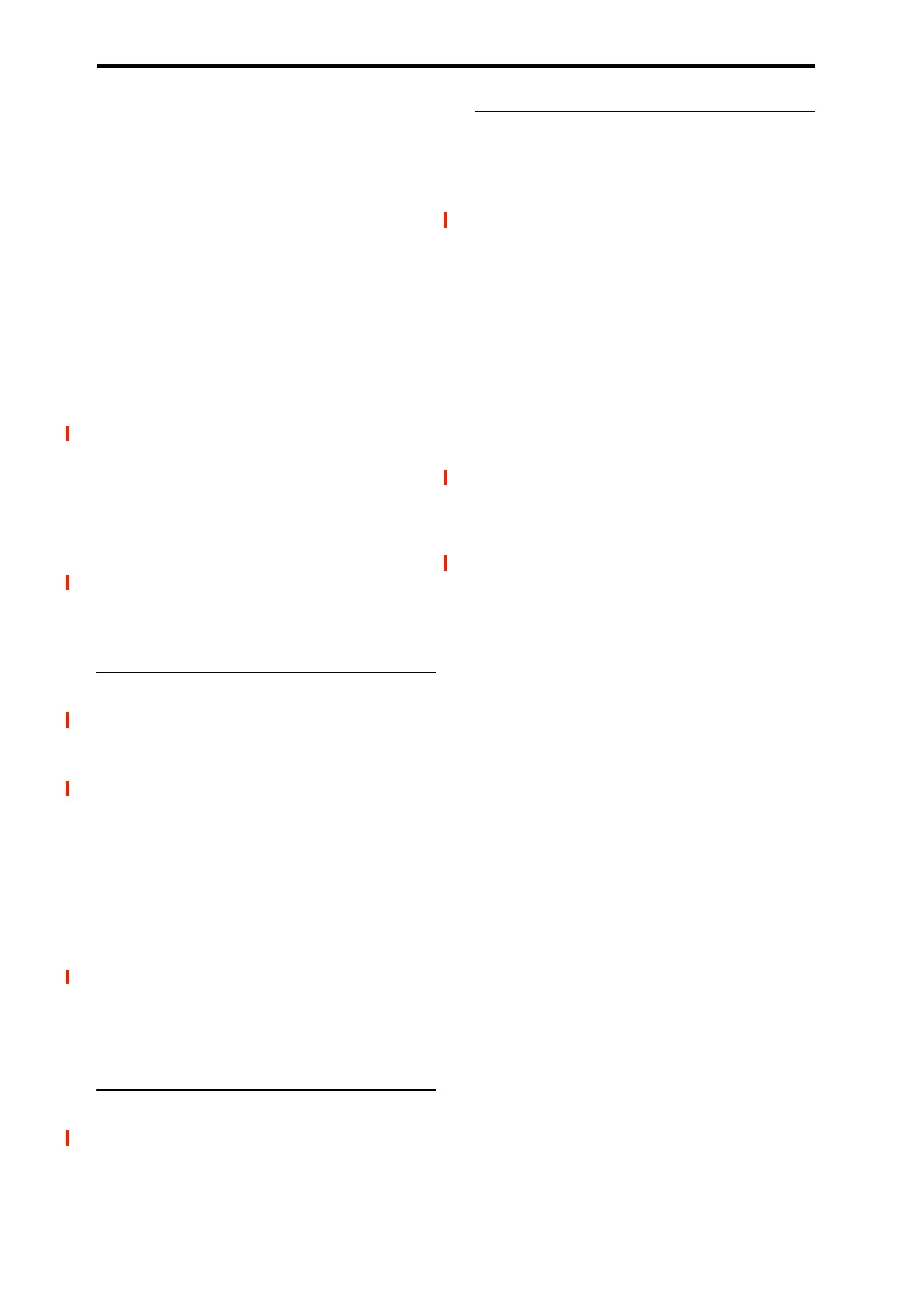EXi: AL-1 Analog Synthesizer
174
When Key Sync is Off, the Step Sequencers for all notes are
synchronized together (unless the Start Step is modulated
by note-specific AMS sources). The first note in a legato
phrase will start from the Start Step; subsequent notes will
play in sync with that first note.
Smoothing
These controls filter the Step Sequencer’s output signal,
creating more gentle transitions between values. You can use
this to round off the hard edges of the Step Sequencer’s
output, or to create envelope-like effects.
You have separate control of the amount of smoothing
during the attack (when the signal is increasing) and decay
(when it’s decreasing).
For more information, see “Using Smoothing to create
envelope-like shapes” on page 137, and “Using Smoothing
to make step transitions more gentle” on page 137.
Attack [00…99]
This controls the attack time of the smoother, or how long it
takes to reach a new, higher value.
Higher Attack settings mean longer times.
Depending on how quickly the Step Sequencer value is
changing, high Attack settings may mean that a new value is
never quite reached.
Decay [00…99]
This controls the decay time of the smoother, or how long it
takes the smoother to reach a new, lower value.
Higher Decay settings mean longer times.
8–1b: Sequencer Reset
AMS [List of AMS Sources]
This selects an AMS source to reset the sequence to the
Start Step.
Threshold [-99…+99]
This sets the AMS level which will make the Step Sequencer
reset. Among other things, you can use this to adjust the
exact point in an LFO’s phase at which the sequencer will be
reset, effectively controlling its “groove” against other
rhythmic effects.
When the threshold is positive, the Step Sequencer triggers
when passing through the threshold moving upwards. When
the threshold is negative, the Step Sequencer triggers when
passing through the threshold moving downwards.
Note: With some LFO shapes, and with faster LFO speeds,
the LFO may not always reach the extreme values of +99 or
-99. In this case, setting the Threshold to these values may
cause inconsistent behavior, or may mean that the Step
Sequencer doesn’t reset at all. If this happens, reduce the
Threshold until the Step Sequencer triggers consistently.
8–1c: Value AMS Input
AMS [List of AMS Sources]
This is the AMS source used for steps set to AMS Input or
AMS Input S/H.
8–1d: Step Parameters
Each of the 32 steps has its own settings for Value and
Duration.
Value 1-32 [-100…+100, Random,
AMS Input, AMS Input S/H]
-100 through +100 generate specific levels, just as you’d
expect.
Random yields a different, random value every time the step
is played.
AMS Input uses the signal from the Value AMS Input
source, above. This can change continuously over the
duration of the step. For instance, if you used an LFO as the
Value AM S Inp ut, you’d hear the LFO move over the
duration of the step.
AMS Input S/H grabs the level of the Value AMS Input
source at the start of the step, and then maintains that single
value for the duration of the step.
Duration (Base Note) 1-32 [ … ]
This sets the basic length of the step, relative to the system
tempo. The values range from a 32nd note to a whole note,
including triplets.
x (Multiply Base Note by…) 1-32 [01…32]
This multiplies the length of the Base Note. For instance, if
the Base Note is set to a sixteenth note, and Times is set to 3,
the step’s duration will be a dotted eighth note.
Command buttons
Step
Step [01…32]
Selects the step that you want to edit.
Insert
Inserts the cut or copied step at the current step.
Cut
Cuts the current step. Subsequent steps will be moved
forward. If desired, you can then paste or insert the cut step
into another location.
Copy
Copies the current step. You can then paste or insert the
copied step into another location.
Paste
Pastes the cut or copied step onto the current step, replacing
it.
Value
Reset
Resets the “Value” of each step to 000.
Smooth
Automatically adjusts the “Value” of each step so that they
are smoothly connected.

